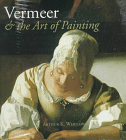The Beauty in Ordinary Things
Interview by Linda M. Castellitto
 A little glass pitcher started it all.
A little glass pitcher started it all.
Says Susan Vreeland, author of the Book Sense 76 pick* Girl in Hyacinth Blue, "I can tell you the moment I sensed I wanted to tell stories about things in museums: In the L.A. County Museum of Art, I found a small glass medicine pitcher - only four inches high - shaped like an animal, with a snout for the spout. The sign next to it said, 'Phoenicia, 2nd century.' And I thought, how many hands did it pass through before I got to see it? Who was the craftsman who blew this? What was his life like? Was his village in want or in plenty? What did his kids want from him that day? Did he feel the sun baking the back of his neck as he blew the glass?"
 That inquisitiveness, that urge to discover the story behind the art, was a driving force behind the creation of the stories that together became Girl in Hyacinth Blue. Vreeland is no stranger to writerly pursuits -- she taught high school English for 30 years, authored What Love Sees in 1988, and has written some 25 short stories since then -- but it is only now that she is feeling the "POW!" (as she calls it) of having authored a book that strongly resonates with readers the world over.
That inquisitiveness, that urge to discover the story behind the art, was a driving force behind the creation of the stories that together became Girl in Hyacinth Blue. Vreeland is no stranger to writerly pursuits -- she taught high school English for 30 years, authored What Love Sees in 1988, and has written some 25 short stories since then -- but it is only now that she is feeling the "POW!" (as she calls it) of having authored a book that strongly resonates with readers the world over.
That, Vreeland notes, was not her initial intention: "My goal at the time [I wrote the book] wasn't to create a novel that would make it out in the big world. It was to have enough time left in my life to finish this group of stories and print out 12 copies, so my husband could give them to members of my writing group so they'd have something to remember me by."
 Vreeland's 1996 lymphoma diagnoisis lent her task a poignant urgency -- but it also bestowed upon her a heightened appreciation of the beauty in her surroundings, an appreciation that has colored her writing. "I remember the first time, after a bone marrow transplant and the 100 days of solitude and confinement that followed, the world was glorious," she says. "Every little blade of grass was sticking up and doing its part to make the world glorious, every breeze was a blessing. The impatiens were a deep magenta, and I thought, 'What a God, to have conceived such a color.' So anything in the book that is an intense description of landscape, that shows tenderness - it is because of the tenderness toward the world that I was feeling myself."
Vreeland's 1996 lymphoma diagnoisis lent her task a poignant urgency -- but it also bestowed upon her a heightened appreciation of the beauty in her surroundings, an appreciation that has colored her writing. "I remember the first time, after a bone marrow transplant and the 100 days of solitude and confinement that followed, the world was glorious," she says. "Every little blade of grass was sticking up and doing its part to make the world glorious, every breeze was a blessing. The impatiens were a deep magenta, and I thought, 'What a God, to have conceived such a color.' So anything in the book that is an intense description of landscape, that shows tenderness - it is because of the tenderness toward the world that I was feeling myself."
The melding of beauty and spirituality and tenderness, Vreeland feels, is one of the elements of Girl that serves to lure the reader along the path of a fictional, as-yet-undiscovered painting by Johannes Vermeer. We follow the painting back in time, from its ownership in the present day back to World War II, and back further still to 17th-century Amsterdam - when Vermeer created the painting. Each of the eight stories in Girl offers a different approach to and understanding of the painting, notes Vreeland. "The characters who came in contact with that painting saw it in so many different ways. That painting serves probably 15 or 20 different functions in the course of my eight stories. A Nazi and a farm wife, absolutely unschooled, appreciate it equally."
And what they are appreciating is not solely the aesthetic value of the painting, but the humanity of the girl, Magdalena -- Vermeer's daughter -- it depicts. "My book shows you can respond just as one human to another human painted on canvas," Vreeland says.
 Magdalena's humanity is amplified when we realize that she, the painted, also had a painter's eye -- but lacked a way to exercise her talent. Explains Vreeland, "If Vermeer did teach Magdalena to paint, she would've had no career open to her. It would've been considered a waste of his time. But in the book, Magdalena says that not knowing how to paint maybe has made the years easier: Her life might have been more painful because she would've felt something she could express…if only she had lived in a different century."
Magdalena's humanity is amplified when we realize that she, the painted, also had a painter's eye -- but lacked a way to exercise her talent. Explains Vreeland, "If Vermeer did teach Magdalena to paint, she would've had no career open to her. It would've been considered a waste of his time. But in the book, Magdalena says that not knowing how to paint maybe has made the years easier: Her life might have been more painful because she would've felt something she could express…if only she had lived in a different century."
This inability to fully express oneself resonates through many of the eight stories in Girl in Hyacinth Blue. For example, Vreeland points, out, "The idea of unexpressed pain is there with Magdalena, and also with Hannah, the daughter of the Jewish family who owned the painting before they were deported. I wanted my Hannah to be the antithesis of Anne Frank. They lived in the same neighborhood, and while Anne's family chose to go into hiding, Hannah's did not. Of course the outcome was the same, but whereas Anne was vibrant and talkative and outspoken, Hannah was inarticulate and inward. I think that's why she felt so much connection to the painting, which was also silent. She was more private and the pain was stronger. So it's the pain in expression that Hannah shared with Magdalena. She wanted to paint, she had the eye of a painter, but didn't have the means to make it happen."
In her upcoming novel, though, things are turned around. Artemisia, the subject of The Passion of Artemisia, due out in fall 2001, "is the daughter of a painter who did teach her, and she became one of the earliest women to make a contribution to art history. Her art allowed her to live through [her own trying times]. And, if you call my writing an art, that helped me to live through my trouble. Not having that means of expression is what made Magdalena and the outcome of her life so grievous," says Vreeland.
 But Vreeland's own outcome was a happy one, and she says she has been able to appreciate the things she learned while she was ill, to share that appreciation with her readers. One way of doing so is, of course, through her writing. In addition to the upcoming Artemisia, she has written a short-story volume called Uncommon Clay, and is working on another novel, Cedar Spirits, about Canadian artist Emily Carr. She adds, "I owe a great deal to my original publisher, a small house willing to take a risk on an unknown author. Likewise, I owe a great deal to independent booksellers, who take an independent look at books that come from the small presses. Together they can keep our national literary canon broad, so that we can hear the voices we need to."
But Vreeland's own outcome was a happy one, and she says she has been able to appreciate the things she learned while she was ill, to share that appreciation with her readers. One way of doing so is, of course, through her writing. In addition to the upcoming Artemisia, she has written a short-story volume called Uncommon Clay, and is working on another novel, Cedar Spirits, about Canadian artist Emily Carr. She adds, "I owe a great deal to my original publisher, a small house willing to take a risk on an unknown author. Likewise, I owe a great deal to independent booksellers, who take an independent look at books that come from the small presses. Together they can keep our national literary canon broad, so that we can hear the voices we need to."
She is also reaching out to her readers via speaking engagements: "I love touring. I think I'm rather intimate in [these appearances], in sharing the origins of my book, the experience of going through an illness. In almost every instance someone comes up to me afterward, sometimes tearfully, telling me about their own or a family member's experience with cancer."
 She adds, "I feel I have been allowed to survive in order to carry a message about survival. There is a line my Magdalena says, a fragment of a sentence: 'soul enough to speak.' That's what I hope I'm developing and bringing to others. Cancer is touching so many people, and we need words of encouragement, to recognize spiritual power -- whether it be through organized religion, looking at a flower or a painting, or experiencing the love of friends and family and strangers."
She adds, "I feel I have been allowed to survive in order to carry a message about survival. There is a line my Magdalena says, a fragment of a sentence: 'soul enough to speak.' That's what I hope I'm developing and bringing to others. Cancer is touching so many people, and we need words of encouragement, to recognize spiritual power -- whether it be through organized religion, looking at a flower or a painting, or experiencing the love of friends and family and strangers."
* A November/December 2000 Book Sense 76 Pick
"My FAVORITE book last year!! Like a little jewel in one's hand, this book sparkles with charm and inventiveness. My only wish was that it had been longer so that I could have had more stories about the painting."
- Britton Trice, Garden District Book Shop, New Orleans, LA
